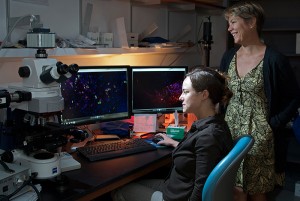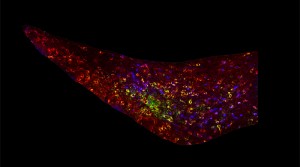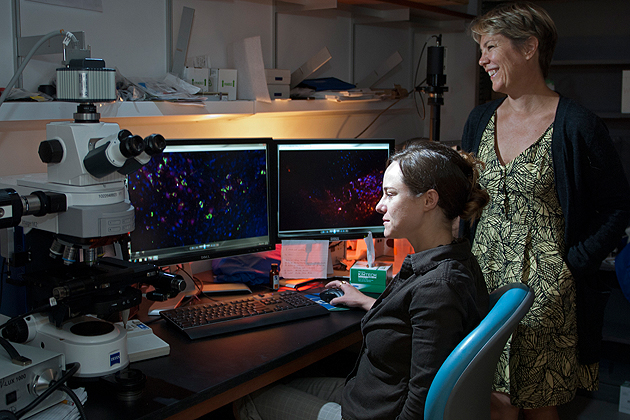
A team of neuroscientists in UConn’s College of Liberal Arts and Sciences has mapped the brain’s nerve connections that help control the sense of smell, which could add another brain region to the list of those affected by Parkinson’s Disease.
“Scientists are very interested in the connectivity of the brain,” says Joanne Conover, associate professor in the Department of Physiology and Neurobiology. “The better we can define the neuron populations in the brain, the better we can grasp how they are targeted for degeneration in diseases like Parkinson’s.”
Conover’s graduate student Jessica Lennington led a study focused on one of the few parts of the brain that continues to produce new neurons from stem cells after embryonic development and throughout adulthood. The region, called the subventricular zone, or SVZ, is in the center of the brain and plays a role in controlling animals’ sense of smell.
Clinical studies show that patients with Parkinson’s disease often gradually lose their sense of smell as the disease progresses. Neurobiologists think that this loss has to do with changes in signaling by dopamine – one of the most important signaling molecules in the brain – within and around the SVZ.
“People are looking for factors that regulate the SVZ, and dopamine is one of these factors,” Conover says. “We wanted to know: where is the dopamine coming from?”

Scientists previously thought a nearby brain region that controls motor function was sending dopamine to the SVZ. Lennington tested this idea using a fluorescent dye to trace the path of the dopamine neurons from the SVZ to their site of origin in the midbrain, which she visualized under a confocal microscope.
What she found was completely unexpected.
“In all cases, there was a little region that was lighting up in a different part of the midbrain, not the region that others had previously assumed to be the origin,” she says.
The midbrain area that glowed with dopamine molecules is involved in basic processes like motivation, aversion, and rewards, which Conover and Lennington point out are intuitively associated with smell.
And being able to smell things, says Lennington, has been associated throughout evolution not just with deciding whether something’s good to eat, but with a host of survival decisions.
“It’s also involved in mating, parenting, and sensing seasonal changes,” she says.
This discovery, says Conover, suggests that Parkinson’s disease may also affect an area of the brain not previously associated with the disease. Although this study looked at mouse brains according to National Institutes of Health standards, Conover thinks the same could be true in the human brain.
Studies like these are the necessary small steps in understanding how all the many sections of the brain communicate with one another, she says.
“This was not an easy project because our data suggested something different from what others had previously reported. We had to prove what was going on while disproving others’ work,” says Conover. “It’s exciting to have it all come together.”
Lennington, who will defend her doctoral dissertation this semester, says that future work in this area will continue identifying the differences between populations of nerve cells that use dopamine in the brain.
“It’s still not known why the neurons involved in Parkinson’s degenerate,” says Conover. “We can speculate, but we don’t have this all figured out.”
Also involved in the study were former student Sara Pope, and current undergraduates Anna Goodheart and Linda Drozdowicz, physiology and neurobiology majors, and Board of Trustees Distinguished Professor of Psychology John Salamone. Stephen Daniels of the Department of Physiology and Neurobiology also participated in the study. The study was published on Sept. 14 in the Journal of Neuroscience.



